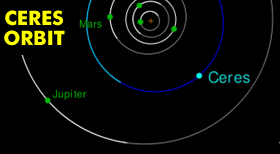Dwarf Planets
11.1 - Be able to use data about the names and relative locations of bodies in the Solar System, including:b) dwarf planets
The International Astronomy Union ruled in 2006 that Pluto was no longer to be classed as a planet and that it would be known as a dwarf planet, along with Eris and Ceres.
The discovery of Eris led to many questioning Pluto's status. Eris was larger and has a greater mass. Some thought it should be classed as a planet, although like Pluto, it too was small and had an eccentric orbit compared to other planets.
Since 2006 other objects have been classed as dwarf planets.
The classification of a dwarf planet is difficult to follow and is still an area of controversy in the astronomy community.
Briefly, the criteria for a dwarf planet is this (You do not have to know the following information but is provided here for fun) :
- Is in orbit around the Sun
- Is not a satellite
- Has sufficient mass for its self-gravity to overcome rigid body forces so that it assumes a hydrostatic equilibrium (to some this means a near-spherical or consistent shape).
- Has not cleared the neighbourhood around its orbit (that is that other larger bodies such as Neptune do not cross it)
In the table opposite, Ceres orbits the Sun between Mars and Jupiter. The others (most of the time) orbit outside Neptune's orbit.
Data
| Name | AU | Period | Inc | Diameter km | Mass |
|---|---|---|---|---|---|
| Ceres | 2.7 | 4.6 | 10.5 | 946 | 0.00015 |
| Pluto | 39.5 | 248 | 17 | 2,372 | 0.00218 |
| Haumea | 43.3 | 285 | 28 | 1,400 | 0.00066 |
| Makemake | 45.8 | 310 | 29 | 1,420 | 0.0005 |
| Eris | 67.7 | 557 | 44 | 2,326 | 0.0028 |
Links
- Dwarf Planets National Geographic
- Dwarf Planets Windows to the Universe
- Dwarf Planets Nine Planets








 | © All Rights Reserved |
| © All Rights Reserved |